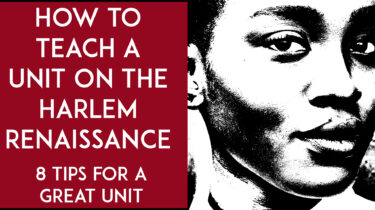How to Teach a Unit on the Harlem Renaissance

There is so much incredible art to explore from Harlem Renaissance, that it might seem overwhelming to do the movement justice. I’ve spent a lot of time researching and reading and exploring to put together a complete unit on the Harlem Renaissance, and this is what I’ve learned about what is most important to include in yours.
Here are my top 8 tips for teaching a great unit on the Harlem Renaissance.
- Read some canonical texts and some lesser known works. Most high school students will read Langston Hughes’ iconic poem “Harlem” before they graduate, and for good reason! In a few short lines of poetry, Hughes makes powerful impact on any reader. But there are so many other texts to explore from the time. “John Redding Goes to Sea” is a personal favorite of mine. In Zora Neale Hurston’s first ever published piece of fiction, she tells the story of a young man who wants to leave his small town and travel the world, but just like the wooden boats that he plays with as a child, he gets caught up in the weeds and prevented from reaching his destination. It’ a great story for discussing dreams and what keeps us from achieving them. Other favorites of mine include Claude McKay’s poem “If We Must Die” and the challenging, powerful poem “Sonnet to a Negro in Harlem” by Helene Johnson.
- Listen to lots and lots of music. Not only was there so much music around during the Harlem Renaissance, so much of the literature of the time was inspired by the music as well. Can you truly appreciate a Langston Hughes poem if you don’t know what jazz sounds like? Can you fully understand Zora Neale Hurtson’s masterful story “Sweat” without knowing the history of Spirituals? I definitely recommend incorporating music whenever possible into you lesson plans.
- Give your students an understanding of the historical context. Without the Great Migration, there would have been no Harlem Renaissance. My favorite way to quickly cover that history with students is to watch and discuss Isabel Wilkerson’s powerful TED Talk “The Great Migration and the power of a single decision.” Similarly, if students know nothing about the events of the “Red Summer,” they’ll never truly understand the reasons behind Claude McKay’s statement that “Like men we’ll face the murderous, cowardly pack, / Pressed to the wall, dying, but fighting back!” So I highly suggest that you incorporate historical context into your unit on the Harlem Renaissance.
- Examine the big questions. There are a lot of big questions to explore when you examine the art of this time, and while your students won’t find easy answers, they’ll get so much out of just asking those questions. What did it mean to be an African American artist at the beginning of the 20th century? What were the different expectations for a “Negro Artist,” and how did various artists accept and rebel against those limitations? How were artists affected by what W.E.B. DuBois described as the “double-consciousness, this sense of always looking at one’s self through the eyes of others”? What was life like for African Americans while “the Negro was in vogue”? Examining these big questions is also a great opportunity to incorporate some non-fiction into your plans.
- Explore different art forms with your students. While an English class will obviously read poetry, short stories, and essays, there was so much going on at the time that it would be a crime if you didn’t work in some music and visual art as well. Enjoying the work of Aaron Douglas, Bessie Smith, Clara Smith, and so many others together with your classes will make your unit more complete and more enjoyable for sure.
- Give students a way to synthesize their learnings. If you want your classes to truly remember what they learn from the unit, you want to make sure that you’re not just covering it and moving on to the next topic. My favorite ways for students to show their understanding are to have them participate in a graded discussion (which I observe but stay hands-off) or by writing an in-class essay based on one or more of the essential questions of the unit. This gives them a chance to bring it all together and really process the various themes, ideas, and texts we have studied together.
- Examine the ways in which America’s history of slavery, reconstruction, and institutionalized racism affected artists during the Harlem Renaissance. The Harlem Renaissance was more than just fabulous parties— it was a time in history in which artists were struggling against a myriad of systematic forms of oppression. It’s important to both understand and appreciate the ways in which they resisted and rebelled against those systems, and to read the poetry, stories, and essays of the time in that context.
- Don’t make this unit a side-note. If you’re teaching the Harlem Renaissance as a supplement to another novel or play, you’re doing a disservice to the artists of the time. The Harlem Renaissance was an amazing time, and it deserves to be taught as a stand-alone unit. Schedule out a few weeks, explore as many texts as you can, and really dig deep.
Ready to teach a unit that is based on all of these best practices? Click here to get my innovative, engaging unit on the Harlem Renaissance.and you can start teaching impactful and fun lessons tomorrow.